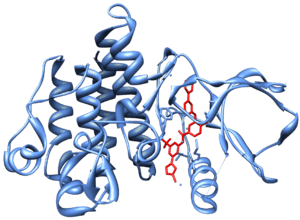Tyrosine-kinase inhibitor

A tyrosine kinase inhibitor (TKI) is a pharmaceutical drug that inhibits tyrosine kinases. Tyrosine kinases are enzymes responsible for the activation of many proteins by signal transduction cascades. The proteins are activated by adding a phosphate group to the protein (phosphorylation), a step that TKIs inhibit. TKIs are typically used as anticancer drugs. For example, they have substantially improved outcomes in chronic myelogenous leukemia.
They are also called tyrphostins, the short name for “tyrosine phosphorylation inhibitor”, originally coined in a 1988 publication,[1] which was the first description of compounds inhibiting the catalytic activity of the epidermal growth factor receptor (EGFR).
The 1988 study was the first demonstration of a systematic search and discovery of small-molecular-weight inhibitors of tyrosine phosphorylation, which do not inhibit protein kinases that phosphorylate serine or threonine residues and can discriminate between the kinase domains of the EGFR and that of the insulin receptor. It was further shown that in spite of the conservation of the tyrosine-kinase domains one can design and synthesize tyrphostins that discriminate between even closely related protein tyrosine kinases such as EGFR and its close relative HER2.[2][3]
Development of drugs
Numerous TKIs aiming at various tyrosine kinases have been generated by the originators of these compounds and proven to be effective anti-tumor agents and anti-leukemic agents.[4][5] Based on this work imatinib was developed against chronic myelogenous leukemia (CML)[6] and later gefitinib and erlotinib aiming at the EGF receptor. Sunitinib, an inhibitor of the receptors for FGF, PDGF and VEGF is also based on early studies on TKIs aiming at VEGF receptors.[7] Cabozantinib, developed by Exelixis and approved by the FDA in 2016, appears to be on its way to the standard of care in regards to TKIs.
Mechanisms
TKIs operate by four different mechanisms: they can compete with adenosine triphosphate (ATP), the phosphorylating entity, the substrate or both or can act in an allosteric fashion, namely bind to a site outside the active site, affecting its activity by a conformational change.[8] Recently TKIs have been shown to deprive tyrosine kinases of access to the Cdc37-Hsp90 molecular chaperone system on which they depend for their cellular stability, leading to their ubiquitylation and degradation.[9] Signal transduction therapy can in principle also apply for non-cancer proliferative diseases and for inflammatory conditions.[10] Until now TKIs have not been developed for the treatment of such conditions.
See also
References
- ↑ Yaish P, Gazit A, Gilon C, Levitzki A (1988). "Blocking of EGF-dependent cell proliferation by EGF receptor kinase inhibitors". Science. 242 (4880): 933–935. Bibcode:1988Sci...242..933Y. doi:10.1126/science.3263702. PMID 3263702.
- ↑ Gazit A, Osherov N, Posner I, Yaish P, Poradosu E, Gilon C, Levitzki A (1991). "Tyrphostins. 2. Heterocyclic and alpha-substituted benzylidenemalononitrile tyrphostins as potent inhibitors of EGF receptor and ErbB2/neu tyrosine kinases". J Med Chem. 34 (6): 1896–907. doi:10.1021/jm00110a022. PMID 1676428.
- ↑ Osherov N, Gazit A, Gilon C, Levitzki A (1993). "Selective inhibition of the epidermal growth factor and HER2/neu receptors by tyrphostins". J Biol Chem. 268 (15): 11134–42. PMID 8098709.
- ↑ Anafi M, Gazit A, Zehavi A, Ben-Neriah Y, Levitzki A (1993). "Tyrphostin-induced inhibition of p210bcr-abl tyrosine kinase activity induces K562 to differentiate". Blood. 82 (12): 3524–9. PMID 7505115.
- ↑ Meydan N, Grunberger T, Dadi H, Shahar M, Arpaia E, Lapidot Z, Leeder JS, Freedman M, Cohen A, Gazit A, Levitzki A, Roifman CM (1996). "Inhibition of acute lymphoblastic leukaemia by a Jak-2 inhibitor". Nature. 379 (6566): 645–8. Bibcode:1996Natur.379..645M. doi:10.1038/379645a0. PMID 8628398.
- ↑ Druker BJ, Tamura S, Buchdunger E, Ohno S, Segal GM, Fanning S, Zimmermann J, Lydon NB (1996). "Effects of a selective inhibitor of the Abl tyrosine kinase on the growth of Bcr-Abl positive cells". Nat Med. 2 (5): 561–6. doi:10.1038/nm0596-561. PMID 8616716.
- ↑ Strawn LM, McMahon G, App H, Schreck R, Kuchler WR, Longhi MP, Hui TH, Tang C, Levitzki A, Gazit A, Chen I, Keri G, Orfi L, Risau W, Flamme I, Ullrich A, Hirth KP, Shawver LK (1996). "Flk-1 as a target for tumor growth inhibition". Cancer Res. 56 (15): 3540–5. PMID 8758924.
- ↑ Posner I, Engel M, Gazit A, Levitzki A (1994). "Kinetics of inhibition by tyrphostins of the tyrosine kinase activity of the epidermal growth factor receptor and analysis by a new computer program". Mol Pharmacol. 45 (4): 673–83. PMID 8183246.
- ↑ Polier; et al. (2013). "ATP-competitive inhibitors block protein kinase recruitment to the Hsp90-Cdc37 system". Nture Chem Biol. 9 (5): 307–312. doi:10.1038/nchembio.1212. PMID 23502424.
- ↑ Levitzki A, Mishani E (2006). "Tyrphostins and other tyrosine kinase inhibitors". Annu Rev Biochem. 75: 93–109. doi:10.1146/annurev.biochem.75.103004.142657. PMID 16756486.